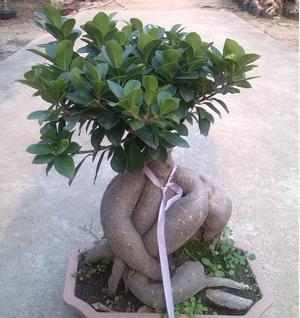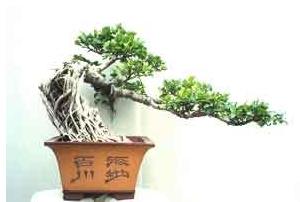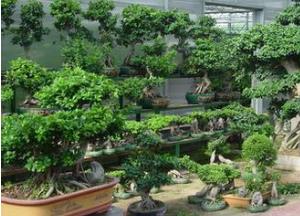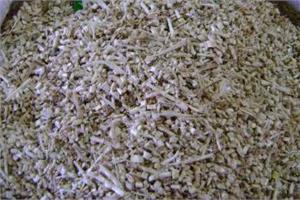The pruning method of how to raise banyan bonsai at home
I believe that for all flower friends, the banyan tree is the most familiar flower. We often grow it in bonsai. And the banyan bonsai is one of our most common bonsai, which is evergreen and graceful. Maintenance is also relatively simple, and it is the first choice for beginners of bonsai. Now I will introduce you to the knowledge of how to plant and cut banyan bonsai.

First, banyan bonsai
The roots of banyan bonsai are intertwined, undulating, simple and beautiful, with good appreciation value. It is a traditional bonsai and is deeply loved by people. Generally, the banyan bonsai should be placed in a ventilated and transparent place with certain space humidity, insufficient sunlight, poor ventilation and no certain space humidity, which can easily make the plant yellow and dry, leading to the occurrence of diseases and insect pests and even death. Acid-loving soil is a non-cold-tolerant plant. In the north, it is usually maintained and managed in greenhouse in winter. In order to maintain the banyan bonsai well, we must carry on the scientific management in the aspects of watering, fertilization, pruning, pest control and so on.
Second, how to raise banyan bonsai

I. maintenance mode
Soil requirements: the general requirements for the cultivation of banyan bonsai are loose and acidic black stone silt, river sand, building stone powder, cinder and so on, and these cultivated soils are easy to obtain.
Watering requirements: banyan bonsai cultivation to cultivate soil to cover the roots, planting trees at a depth of about 3 inches is appropriate. After dripping with fixed root water, place it in a cool leeward place for maintenance, and cover the ground with shade. Watering can be determined according to the weather conditions, keep the culture soil moist and unsoiled, too much waterlogging is easy to cause root blackening and necrosis. After survival, the banyan tree is waterlogged for a long time, which is easy to cause only roots but not branches. If the tree is not watered for two or three days in dog days, the tree will not die, but as soon as it is watered, the leaves will wither and fall off, affecting growth. Therefore, the management of water should be dry and wet.

Fertilization requirements: the banyan tree is a tree species that likes flood and fertilizer, can endure drought and moisture. After the stump entered the normal nursing, the rotten human and animal feces and urine or compost cake fertilizer were used as topdressing and applied outside the root once or twice a day. When transplanting or changing pots, you can also use cooked chicken dung, bean cake and bone powder mixed with culture soil as base fertilizer. Sufficient fertilizer will make the branches grow faster and thicker, and can be pruned more times a year, so as to shorten the culture period.
Lighting environment: banyan bonsai should be placed in a ventilated and transparent place with certain space humidity, insufficient sunlight, poor ventilation and no certain space humidity, which can make the plant yellow and dry, leading to the occurrence of diseases and insect pests and even death.
Pruning points: should not blindly cut branches, first let it sprout, just planted the old pile, the first year had better not be cut. If there are too many branches, pruning should be carried out between March and April. Cut off a small number of random branches at a time, and cut them many times. Once it is cut too much, it will affect the growth of the root and the whole stump.

Pruning points: the banyan stump becomes a banyan bonsai, pruning is a very important process. In the first year, we first cultivate its foundation, nourish its essence, erase only the wrong buds, and wait for the branches to grow thick and lignified in the second year before they can be cut. Give priority to shearing, supplemented by binding, it is appropriate to cut once a year, the strong and vigorous ones can be cut twice, and the forked branches growing from the short branches will be cut again after being strong. Over and over again, if you trim it properly, within four years, a good bonsai will appear in front of you.
Pest control: diseases and pests: root damage or decay is also easy to lose leaves, but because roots grow in the soil is difficult to find. Due to long-term do not change the basin or improper fertilizer and water caused rotten root is very common, it is best not to hurt the root, check the root, appropriate pruning dead root, weak root, root injury. Dip it in the growth agent and implant it in the basin. In addition, the root of banyan tree is easy to produce root rot or nodule disease caused by bacteria and fungi, so proper attention should be paid to spraying to prevent and control it. The main pests of banyan trees are aphids, red spiders, scale and so on. Spray leaves with omethoate 500PPM or 50% thiophor wettable powder 1000 times solution spray. Using detergent water or wind oil essence water 0.1% is also very effective.

II. Points for attention
1. Improper watering: the banyan tree must adhere to the principle of not drying and watering thoroughly. The drying here means that the surface of the basin soil is dry, not thoroughly. Of course, even if it is dry, it will not cause great damage to the banyan tree in a short time, because the leaves of the banyan tree are thick and small, and have a certain degree of drought resistance.
2. Improper fertilization: the fertilization of banyan trees should be carried out by applying thin fertilizer frequently to avoid the application of high concentration chemical fertilizer or unfermented mature organic fertilizer, otherwise it will cause fertilizer damage, the light ones will lose their leaves and the heavy ones will die.
3. Lack of light: the banyan tree grows well under sufficient light. In summer, if it can shade 30% to 50%, the leaf color is more green, but when the temperature is lower than 32 degrees, it is best not to shade, so as to avoid leaf shedding.
4. Insect pests: red spiders and shell insects are the main pests that cause leaf loss in banyan trees. Although there are also thrips, this insect only rolls leaves to absorb juice, which is less harmful than the above two kinds, and thrips are easy to control. You can only remove the rolled leaves and destroy them. The individual red spider is relatively small, and the general harmful part is the back of the leaf, which is caused by poor ventilation and dry air. The whole plant can be washed with water and sprayed with special mites, such as mites, acaroid mites and so on. The harmful parts of shell insects are mainly stems and petioles, with different size and color, round and oval in shape, and generally do not move, but they are harmful and need to be prevented and treated in time. They can be wiped clean with a toothbrush or dishcloth, or 0.2% solution of detergent and essential oil can be sprayed, or pesticides such as methamphetamidophos are sprayed with good results.

Third, the pruning method of banyan bonsai
Bonsai trees are still growing, if they are allowed to grow naturally, unrestrained, it is bound to affect the shape of the tree and lose its artistic value. Therefore, it is necessary to prune in time, long-skill short cut, secret skill sparse cutting, in order to maintain beautiful tree posture and appropriate proportion.
1. Heart-picking: bonsai trees can remove their tender tips in order to restrain their height growth and promote the development of lateral techniques.
2. Picking buds: when bonsai trees grow many adventitious buds on their dry base or trunk, they should pick buds at any time to avoid sprouting forked branches and affecting the beauty of the tree.
Picking leaves: bonsai of foliage trees, the viewing period is often the germination period of new leaves, such as mechanical trees, pomegranates and other new leaves are red, through leaf removal treatment, trees can make new leaves several times a year, bright and pleasing to the eye, and improve their ornamental effect.
3. Pruning: bonsai trees often produce many new branches. in order to maintain their beautiful shape, we should always pay attention to the repair skills, which should be determined according to the shape of the tree, such as the shape of clouds. Then the branches will be trimmed into a flat shape, generally hindering the beauty of dead branches, parallel branches, cross techniques, etc., should be cut off in time.
4. Root pruning: combined with root pruning when turning the basin, the root system that is too dense and too long should be pruned, which can be considered according to the following circumstances. If the new root of the tree is underdeveloped and the root system is not covered with the bottom of the soil block, the original basin can still be used to turn the basin, and the tree species with developed root system and fibrous root should be replaced with a larger basin, the dense root system should be thinned, the old root should be removed, and a few new roots should be retained for turning the pot. when turning the basin, some old pile bonsai can be lifted properly to increase its ornamental value, and the old root and root tip can be trimmed to loosen the soil. To promote new roots.
II. Points for attention
1. Improper watering: the banyan tree must adhere to the principle of not drying and watering thoroughly. The drying here means that the surface of the basin soil is dry, not thoroughly. Of course, even if it is dry, it will not cause great damage to the banyan tree in a short time, because the leaves of the banyan tree are thick and small, and have a certain degree of drought resistance.
2. Improper fertilization: the fertilization of banyan trees should be carried out by applying thin fertilizer frequently to avoid the application of high concentration chemical fertilizer or unfermented mature organic fertilizer, otherwise it will cause fertilizer damage, the light ones will lose their leaves and the heavy ones will die.
3. Lack of light: the banyan tree grows well under sufficient light. In summer, if it can shade 30% to 50%, the leaf color is more green, but when the temperature is lower than 32 degrees, it is best not to shade, so as to avoid leaf shedding.
4, caused by insect pests: red spiders and shell insects are the main pests that cause fallen leaves in banyan trees. Although there are also thrips, this insect only rolls leaves to absorb juice, which is less harmful than the above two kinds, and thrips are easy to control. You can only remove and destroy the rolled leaves. The individual red spider is relatively small, and the general harmful part is the back of the leaf, which is caused by poor ventilation and dry air. The whole plant can be washed with water and sprayed with special mites, such as mites, acaroid mites and so on. The harmful parts of shell insects are mainly stems and petioles, with different size and color, round and oval in shape, and generally do not move, but they are harmful and need to be prevented and treated in time. They can be wiped clean with a toothbrush or dishcloth, or 0.2% solution of detergent and essential oil can be sprayed, or pesticides such as methamphetamidophos are sprayed with good results.

Third, the pruning method of banyan bonsai
Bonsai trees are still growing, if they are allowed to grow naturally, unrestrained, it is bound to affect the shape of the tree and lose its artistic value. Therefore, it is necessary to prune in time, long-skill short cut, secret skill sparse cutting, in order to maintain beautiful tree posture and appropriate proportion.
1. Heart-picking: bonsai trees can remove their tender tips in order to restrain their height growth and promote the development of lateral techniques.
2. Picking buds: when bonsai trees grow many adventitious buds on their dry base or trunk, they should pick buds at any time to avoid sprouting forked branches and affecting the beauty of the tree.
Picking leaves: bonsai of foliage trees, the viewing period is often the germination period of new leaves, such as mechanical trees, pomegranates and other new leaves are red, through leaf removal treatment, trees can make new leaves several times a year, bright and pleasing to the eye, and improve their ornamental effect.
3. Pruning: bonsai trees often produce many new branches. in order to maintain their beautiful shape, we should always pay attention to the repair skills, which should be determined according to the shape of the tree, such as the shape of clouds. Then the branches will be trimmed into a flat shape, generally hindering the beauty of dead branches, parallel branches, cross techniques, etc., should be cut off in time.
4. Root pruning: combined with root pruning when turning the basin, the root system that is too dense and too long should be pruned, which can be considered according to the following circumstances. If the new root of the tree is underdeveloped and the root system is not covered with the bottom of the soil block, the original basin can still be used to turn the basin, and the tree species with developed root system and fibrous root should be replaced with a larger basin, the dense root system should be thinned, the old root should be removed, and a few new roots should be retained for turning the pot. when turning the basin, some old pile bonsai can be lifted properly to increase its ornamental value, and the old root and root tip can be trimmed to loosen the soil. To promote new roots.
Related
- Wuhan Hospital Iron Tree Blooming Result Was Instantly Frightened by the Gardener Master
- Which variety of camellia is the most fragrant and best? Which one do you like best?
- What is the small blue coat, the breeding methods and matters needing attention of the succulent plant
- Dormancy time and maintenance management of succulent plants during dormancy
- Minas succulent how to raise, Minas succulent plant pictures
- What are the varieties of winter succulent plants
- How to raise succulent plants in twelve rolls? let's take a look at some experience of breeding twelve rolls.
- Attention should be paid to water control for succulent plants during dormant period (winter and summer)
- Watering experience of twelve rolls of succulent plants
- Techniques for fertilizing succulent plants. An article will let you know how to fertilize succulent plants.



